
Scandinavian York or Viking York is a term used by historians for what is now Yorkshire during the period of Scandinavian domination from late 9th century until it was annexed and integrated into England after the Norman Conquest; in particular, it is used to refer to York, the city controlled by these kings and earls. The Kingdom of Jórvík was closely associated with the longer-lived Kingdom of Dublin throughout this period.
Yorkshire is a historic county of England, centred on the county town of York. The region was first occupied after the retreat of the ice age around 8000 BC. During the first millennium AD it was inhabited by celtic Britons and occupied by Romans, Angles and Vikings. The name comes from "Eborakon" an old Brythonic name which probably derives from "Efor" or "the place of the yew-trees." Many Yorkshire dialect words and aspects of pronunciation derive from old Norse due to the Viking influence in this region. The name "Yorkshire", first appeared in writing in the Anglo-Saxon Chronicle in 1065. It was originally composed of three sections called Thrydings, subsequently referred to as Ridings.

The Lloyds Bank coprolite is a large coprolite, or fossilised specimen of human faeces, recovered by the York Archaeological Trust while excavating the Viking settlement of Jórvík in northern England.

The York Archaeological Trust for Excavation and Research Limited (YAT) is an educational charity, established in 1972 in the city of York, England, and trading under the York Archaeology brand. The charity presents archaeology to the public through visitor attractions and events, and its commercial arm carries out archaeological investigations, fieldwork, excavation and research in York and throughout Britain and beyond.

The history of York, England, as a city dates to the beginning of the first millennium AD but archaeological evidence for the presence of people in the region of York dates back much further to between 8000 and 7000 BC. As York was a town in Roman times, its Celtic name is recorded in Roman sources ; after 400, Angles took over the area and adapted the name by folk etymology to Old English Eoforwīc or Eoforīc, which means "wild-boar town" or "rich in wild-boar". The Vikings, who took over the area later, in turn adapted the name by folk etymology to Norse Jórvík meaning "wild-boar bay", 'jór' being a contraction of the Old Norse word for wild boar, 'jǫfurr'. The modern Welsh name is Efrog.

The Coppergate Helmet is an eighth-century Anglo-Saxon helmet found in York, England. It was discovered in May 1982 during excavations for the Jorvik Viking Centre at the bottom of a pit that is thought to have once been a well.

Jorvik Viking Centre is a museum and visitor attraction in York, England, containing lifelike mannequins and life-size dioramas depicting Viking life in the city. Visitors are taken through the dioramas in 'time capsule' carriages equipped with speakers. It was created by York Archaeological Trust and opened in 1984. Its name is derived from Jórvík, the Old Norse name for York and the surrounding Viking Kingdom of Yorkshire.
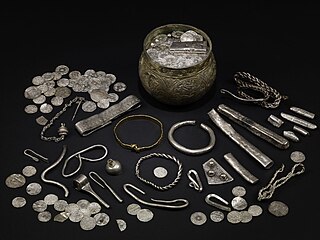
The Vale of York Hoard, also known as the Harrogate Hoard and the Vale of York Viking Hoard, is a 10th-century Viking hoard of 617 silver coins and 65 other items. It was found undisturbed in 2007 near the town of Harrogate in North Yorkshire, England. The hoard was the largest Viking one discovered in Britain since 1840, when the Cuerdale hoard was found in Lancashire, though the Anglo-Saxon Staffordshire Hoard, found in 2009, is larger.
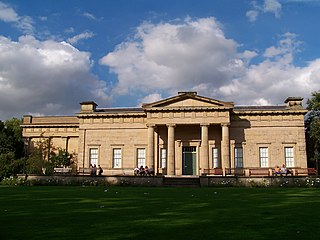
The Yorkshire Museum is a museum in York, England. It was opened in 1830, and has five permanent collections, covering biology, geology, archaeology, numismatics and astronomy.
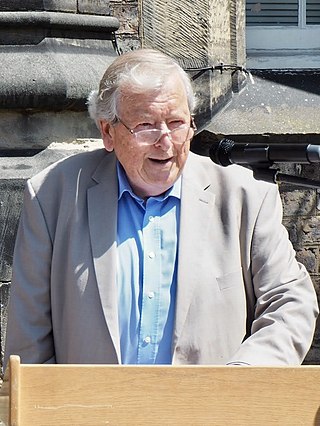
Peter Vincent Addyman,, known as P. V. Addyman, is a British archaeologist who was Director of the York Archaeological Trust from 1972 to 2002. Addyman obtained a degree in archaeology at Cambridge University, after which he lectured at Queen's University Belfast and the University of Southampton, while also conducting excavations. In 1972 he was offered the directorship of the newly founded York Archaeological Trust, the creation of which he had proposed; along with excavation work in York, he oversaw the development of the Jorvik Viking Centre, the Archaeological Resource Centre, and Barley Hall. In 2000 he was appointed a Commander of the Order of the British Empire.

The following is a timeline of the history of the city of York, North Yorkshire in northern England.

Coppergate is a street in the city centre of York, in England. The street runs north-east from the junction of Castlegate, Nessgate, King Street and Clifford Street, to end at the junction of Pavement, Piccadilly, Parliament Street, and High Ousegate.

Elizabeth Grayson Hartley, was an American archaeologist and curator. She spent most of her career as the Keeper of Archaeology at the Yorkshire Museum in York.
Dominic Tweddle,, is an English archaeologist specialising in Anglo-Saxon studies. and the former director general of the National Museum of the Royal Navy. Previously he spent time as a research assistant at the British Museum and as the assistant director of the York Archaeological Trust, where he helped develop the Jorvik Viking Centre. He is also an honorary professor at the UCL Institute of Archaeology and the University of Portsmouth.
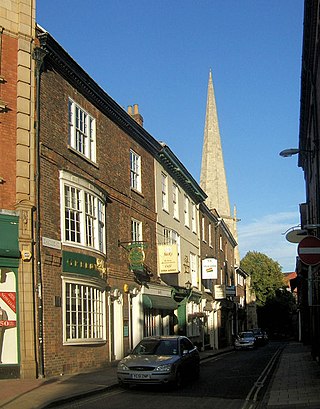
Castlegate is a historic street in York, England, which leads to York Castle.
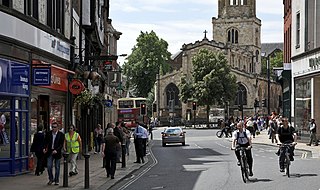
Pavement is a street in the city centre of York, in England.

Ousegate is a street in the city centre of York, in England. It is divided into High Ousegate and Low Ousegate.
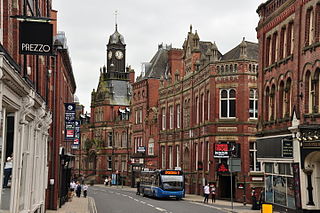
Clifford Street is a road in the city centre of York, in England.
Patrick Ottaway,, is an English archaeologist and author.


















